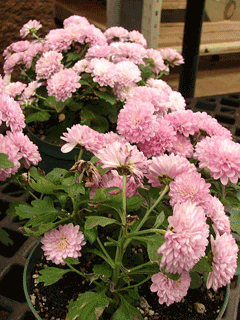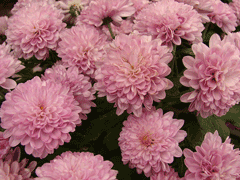 |
|
http://www.hear.org/starr/ |
 |
| http://www.hear.org/starr/ |
Translate this page:
Summary
Bloom Color: Orange, Pink, Purple, Red, White, Yellow.
Main Bloom Time: Early fall, Late summer, Mid fall. Form: Rounded.
Physical Characteristics

 Dendranthema x grandiflorum is a PERENNIAL growing to 1.5 m (5ft) at a medium rate.
Dendranthema x grandiflorum is a PERENNIAL growing to 1.5 m (5ft) at a medium rate.
See above for USDA hardiness. It is hardy to UK zone 4. It is in flower from August to October. The species is hermaphrodite (has both male and female organs) and is pollinated by Insects.
Suitable for: light (sandy), medium (loamy) and heavy (clay) soils. Suitable pH: mildly acid, neutral and basic (mildly alkaline) soils. It cannot grow in the shade. It prefers moist soil.
UK Hardiness Map
US Hardiness Map
Synonyms
Chrysanthemum x morifolium. Ramat. C. sinense.
Plant Habitats
Cultivated Beds;
Edible Uses
Edible Parts: Flowers Leaves
Edible Uses: Tea
The flower heads or petals[46, 116, 179] are parboiled and served as a salad with tofu and seasoned with vinegar or soya sauce[183]. They can also be prepared as tempura, pickled, dried or added to soups[183]. The petals contain about 1.9% protein, 0.9% fat, 5.3% carbohydrate, 0.7% ash[179]. Leaves - cooked[46, 105, 179]. Used as fritters, they are aromatic[183]. Some varieties have been selected for their low bitterness[116]. An aromatic tea is made from the leaves[183]. A tangy aromatic tea is made from the flowers or flower petals[179]. For a sweeter tea only the petals are used[183].
References More on Edible Uses
Medicinal Uses
Plants For A Future can not take any responsibility for any adverse effects from the use of plants. Always seek advice from a professional before using a plant medicinally.
Antibacterial Antifungal Carminative Depurative Diaphoretic Febrifuge Ophthalmic Refrigerant
Sedative
Chrysanthemum flowers, known in China as Ju Hua, are a bitter aromatic herb that has been used for thousands of years in Chinese medicine[238, 254]. The flower heads are drunk as a refreshing tisane and are used to improve vision, soothe sore eyes, relieve headaches, counter infections etc[254]. They are antibacterial, antifungal, anti-inflammatory, carminative, depurative, diaphoretic, febrifuge, ophthalmic, refrigerant and sedative[116, 147, 176, 218, 238]. Taken internally they dilate the coronary artery, thus increasing the flow of blood to the heart, and so are used in the treatment of hypertension, coronary heart diseases and angina[238]. The flowers are harvested when fully open in the autumn and are dried for later use[238]. In China they are steamed before being dried to make them less bitter[238]. The leaf juice is smeared onto wounds[218].
References More on Medicinal Uses
The Bookshop: Edible Plant Books
Our Latest books on Perennial Plants For Food Forests and Permaculture Gardens in paperback or digital formats.

Edible Tropical Plants
Food Forest Plants for Hotter Conditions: 250+ Plants For Tropical Food Forests & Permaculture Gardens.
More

Edible Temperate Plants
Plants for Your Food Forest: 500 Plants for Temperate Food Forests & Permaculture Gardens.
More

More Books
PFAF have eight books available in paperback and digital formats. Browse the shop for more information.
Shop Now
Other Uses
Pollution
Plants have been grown indoors in pots in order to help remove toxins from the atmosphere. It is especially good at removing chemical vapours, especially formaldehyde, benzene and ammonia[259].
Special Uses
References More on Other Uses
Cultivation details
Landscape Uses:Border, Container, Foundation, Massing, Specimen. Succeeds in most well-drained fertile soils in a sunny position[1, 200]. This species is not fully hardy in Britain, many of its cultivars requiring greenhouse protection in the colder areas of the country[1]. The chrysanthemum is widely cultivated as an ornamental flowering plant[200], there are many named varieties. It is also occasionally grown in the Orient for its edible leaves, a number of cultivars have been developed with leaves that are low in bitterness[116]. It has been proposed (1999) to restore this species to Chrysanthemum as C. x morifolium Ramat. since the plant is so widely known under this name. Special Features:Attractive foliage, Fragrant foliage, Attracts butterflies, Suitable for cut flowers, Suitable for dried flowers, Fragrant flowers, Attractive flowers or blooms, Seldomly reblooms.
References Carbon Farming Information and Carbon Sequestration Information
Temperature Converter
Type a value in the Celsius field to convert the value to Fahrenheit:
Fahrenheit:
The PFAF Bookshop
Plants For A Future have a number of books available in paperback and digital form. Book titles include Edible Plants, Edible Perennials, Edible Trees,Edible Shrubs, Woodland Gardening, and Temperate Food Forest Plants. Our new book is Food Forest Plants For Hotter Conditions (Tropical and Sub-Tropical).
Shop Now
Plant Propagation
Seed - sow spring to early summer in a greenhouse and only just cover the seed. It usually germinates in 10 - 18 days at 15°c but if it does not germinate within 4 weeks then try chilling the seed for 3 weeks in the salad compartment of a fridge[164]. When they are large enough to handle, prick the seedlings out into individual pots and plant them out in the summer. This is a hybrid species and so will not breed true from seed. Division in spring. Larger clumps can be replanted direct into their permanent positions, though it is best to pot up smaller clumps and grow them on in a cold frame until they are rooting well. Plant them out in the spring.
Other Names
If available other names are mentioned here
Native Range
Coming Soon
Weed Potential
Right plant wrong place. We are currently updating this section.
Please note that a plant may be invasive in one area but may not in your area so it's worth checking.
Conservation Status
IUCN Red List of Threatened Plants Status :

Growth: S = slow M = medium F = fast. Soil: L = light (sandy) M = medium H = heavy (clay). pH: A = acid N = neutral B = basic (alkaline). Shade: F = full shade S = semi-shade N = no shade. Moisture: D = dry M = Moist We = wet Wa = water.
Now available:
Food Forest Plants for Mediterranean Conditions
350+ Perennial Plants For Mediterranean and Drier Food Forests and Permaculture Gardens.
[Paperback and eBook]
This is the third in Plants For A Future's series of plant guides for food forests tailored to
specific climate zones. Following volumes on temperate and tropical ecosystems, this book focuses
on species suited to Mediterranean conditions—regions with hot, dry summers and cool, wet winters,
often facing the added challenge of climate change.
Read More
Expert comment
Author
(Ramat.)Kitam.
Botanical References
200
Links / References
For a list of references used on this page please go here
Readers comment
© 2010, Plants For A Future. Plants For A Future is a charitable company limited by guarantee, registered in England and Wales. Charity No. 1057719, Company No. 3204567.